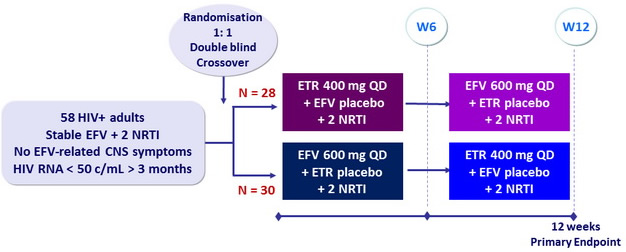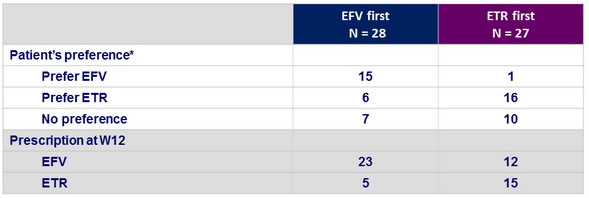Switch studies in virologically suppressed patients
Switch NNRTI to NNRTI
Switch EFV to ETR: Patient's preference
Original article : AIDS. 2011 Jan 2;25(1):57-63 – A Nguyen
Last update :
07/09/2015
Dr Anton Pozniak
Chelsea and Westminster Hospital
London, UK

- Patients on long-term EFV do not, as a rule, prefer ETR after a switch
- In patients who have tolerated an EFV regimen for extended periods, switching to an ETR regimen is of limited benefit insofar, as neuropsychiatric side-effects are a concern
- Patients on ETR, however, had a better lipid profile

Design

Objective
- Primary Endpoint: patient preference of first or second regimen, by questionnaire at W12
- Standardized questionnaires: patient anxiety and depression, sleepiness during the day, sleep quality and antiretroviral satisfaction ( HIVTSQc )
- Plasma drug concentration: D1 and end of both treatment phases
Baseline characteristics and disposition

- Median duration of EFV exposure: 3.9 years (IQR : 1.9-6.6)
Patient's preference and drug prescription at W12, N

* p < 0.0001 (15/21 : 71% vs 16/17 : 91%)
Anxiety, depression and sleep assessment
- No significant differences among depression, anxiety, sleepiness or sleep quality between the two study periods
Safety and laboratory parameters
- Serious adverse events, N = 2, unrelated to study drugs
- Significantly lower lipid levels in patients on ETR when compared with patients on EFV
- Total cholesterol (median change : - 0.7 mmol /l; IQR : - 1.1, - 0.2; p < 0.0001)
- LDL-cholesterol (median change : - 0.6 mmol /l; IQR : - 0.7, - 0.1; p < 0.0001)
- Triglycerides ( median change : - 0.3 mmol /l ; IQR : - 0.9 , - 0.1; p = 0.0002)
 Back to Table of Contents Back to Table of Contents
|



